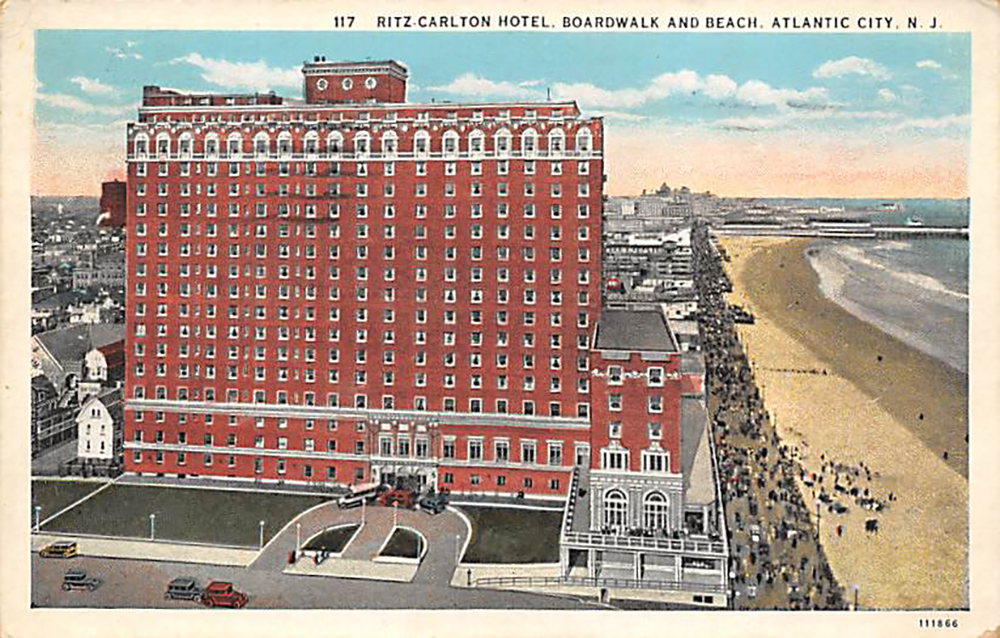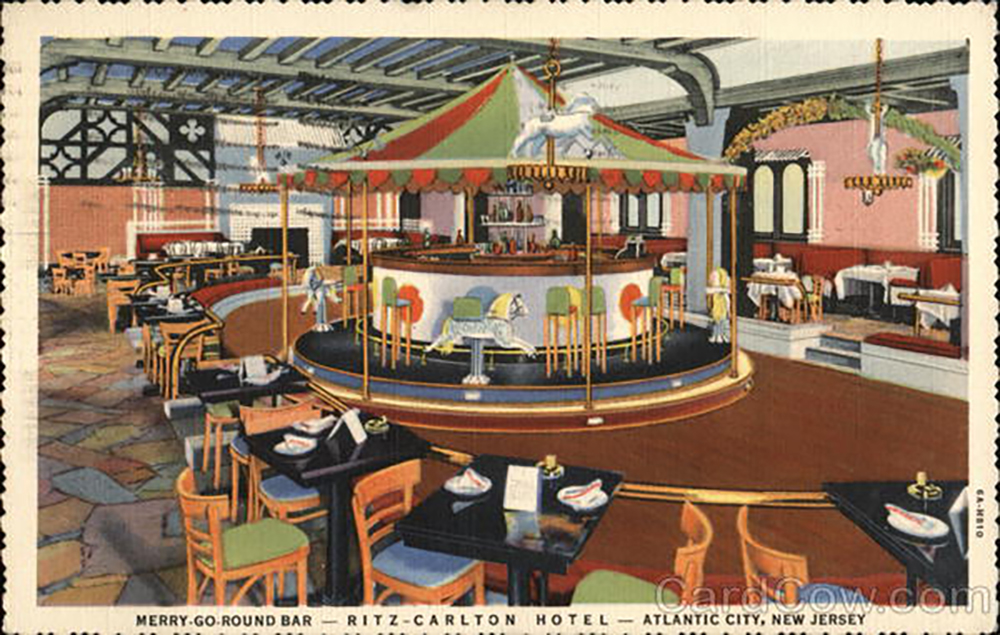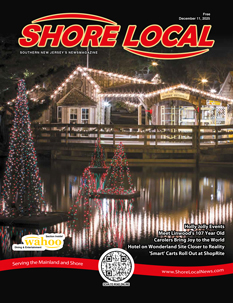By Bruce Klauber
The Ritz Condominiums, at Iowa Avenue and the Boardwalk, is the last of Atlantic City’s grand hotels still standing. And it’s still thriving. Yes, portions of hotels like the Dennis and Haddon Hall are still in use as part of Bally’s and Resorts Casinos, but the Ritz exists today much as it did on the day it opened as the Ritz-Carlton Hotel on June 24,1921.
It’s an incredibly grand structure. Built at a cost of $6 million, which is equal to approximately $100 million today – the building has 17 stories, 600 rooms and fronts 131 feet of the Boardwalk.
Everything about it epitomized the word “grand.” Just some of the features of the hotel in the early days included an on-site well to supply spring water, fresh and salt water faucets in each room, a separate bather’s entrance, a hair salon, a ballroom, a merry-go-round-shaped bar and a “writing room” with antique art. There was a heated indoor pool open year-round, three oceanfront restaurants on the premises, a casino – yes, a gambling casino – and the Ritz-Carlton Terrace, an elegant nightclub which presented the likes of Bing Crosby and Paul Whiteman. Crosby’s appearance at the Ritz’s Terrace was likely his only appearance as a performer in Atlantic City.
When the Ritz was formally dedicated, hotel president Richard Harris said, “We are out to do business with the average American citizen without regard to race, religion or politics.” Though Harris’ heart was certainly in the right place, the truth was that “the average American citizen” could hardly afford to stay at the Ritz for any length of time.
Indeed, some of the early guests included city political boss Enoch “Nucky” Johnson, Herbert Hoover, Calvin Coolidge, Warren G. Harding, New York City Mayor Jimmy Walker, entertainers Eddie Cantor and Sophie Tucker.

To demonstrate that the Ritz was open to one and all, other frequent visitors included underworld crime bosses Al Capone, Lucky Luciano, Arnold Rothstein and Danny Walsh.
The historical record also claims that the Ritz, in 1929, hosted the first national organized crime convention, attended by what was called the “Big Seven Group.” It must have been quite a convention as attendees consisted of Meyer Lansky, Bugsy Siegel, Frank Costello, Joe Adonis, Carlo Gambino and the aforementioned Luciano and Capone.
Johnson reportedly released the entire ninth floor, where he conducted his day-to-day business. According to an article on the WordPress Digital History website, the Ritz was Johnson’s second home.
“Nucky preferred the ninth level of the Ritz-Carlton and rumors suggest that he kept one closet stuffed with cash and an entire room stuffed with bootlegged liquor for his female companions, associates and visiting crime lords.”
The Ritz-Carlton had a spectacular, 16-year run, but even a hotel as grand as the Ritz-Carlton couldn’t weather the storm of the Depression. In 1937, the owners defaulted on their mortgage and reorganized under bankruptcy. It continued to operate, and because of its sheer size, was one of the Atlantic City hotels used as a military barracks for recovering servicemen, and servicemen in training during World War II.
In 1946, new owners came aboard, having purchased the property for $2.5 million, equal to $33 million today, still a tremendous bargain for the time.
The hotel managed to do reasonably good business until 1952 when it was sold again to the owners of the nearby Ambassador Hotel. That ownership lasted only six years, when it was sold to the Sheraton Hotel Company.
Sheraton put almost $1 million into renovations of the property and renamed it The Sheraton Ritz-Carlton, but for unknown reasons, Sheraton sold it only 13 months after they bought it. The new owners, operating under the name “The Ritz of Atlantic City Corporation,” paid $4 million for the Ritz, the same $4 million price that Sheraton paid for it. About 10 years later, the Ritz became an apartment/hotel.
With the advent of legalized gaming in 1978, a group of investors bought the property with the intention of converting it into a hotel/casino. For any number of reasons, that never happened, but the owners were dedicated to ensuring that the Ritz remained grand. In 1982, $25 million was spent to convert the property to around 300 residences and six suites. Not long after, “Carlton” was dropped from the name and the Ritz became “The Ritz Condominiums.”
Today the 101-year-old property continues to thrive as a boardwalk condo that has every contemporary amenity, while still maintaining the standards that made it grand. The Ritz-Carlton Hotel’s mission statement says a lot about the Ritz Condominiums’ heritage as a first-class operation.
“At The Ritz-Carlton, our Ladies and Gentlemen are the most important resource in our service commitment to our guests. By applying the principles of trust, honesty, respect, integrity and commitment, we nurture and maximize talent to the benefit of each individual and the company.”
Here’s to 101 more grand years!


















Great article ! A big chapter of my working career
Centered on the Ritz. I was project manager for Ritz Associates the developers during the Condo conversion from 1982 thru 1985. Later on I was the General Manager of the Ritz Condominium Association from 2003 until I retired in 2015.
Both were amazing jobs. It was great to walk out on the Boardwalk at lunch time. Between air show day and the practice the day before I saw the AF Thunderbirds 26 times. 😀